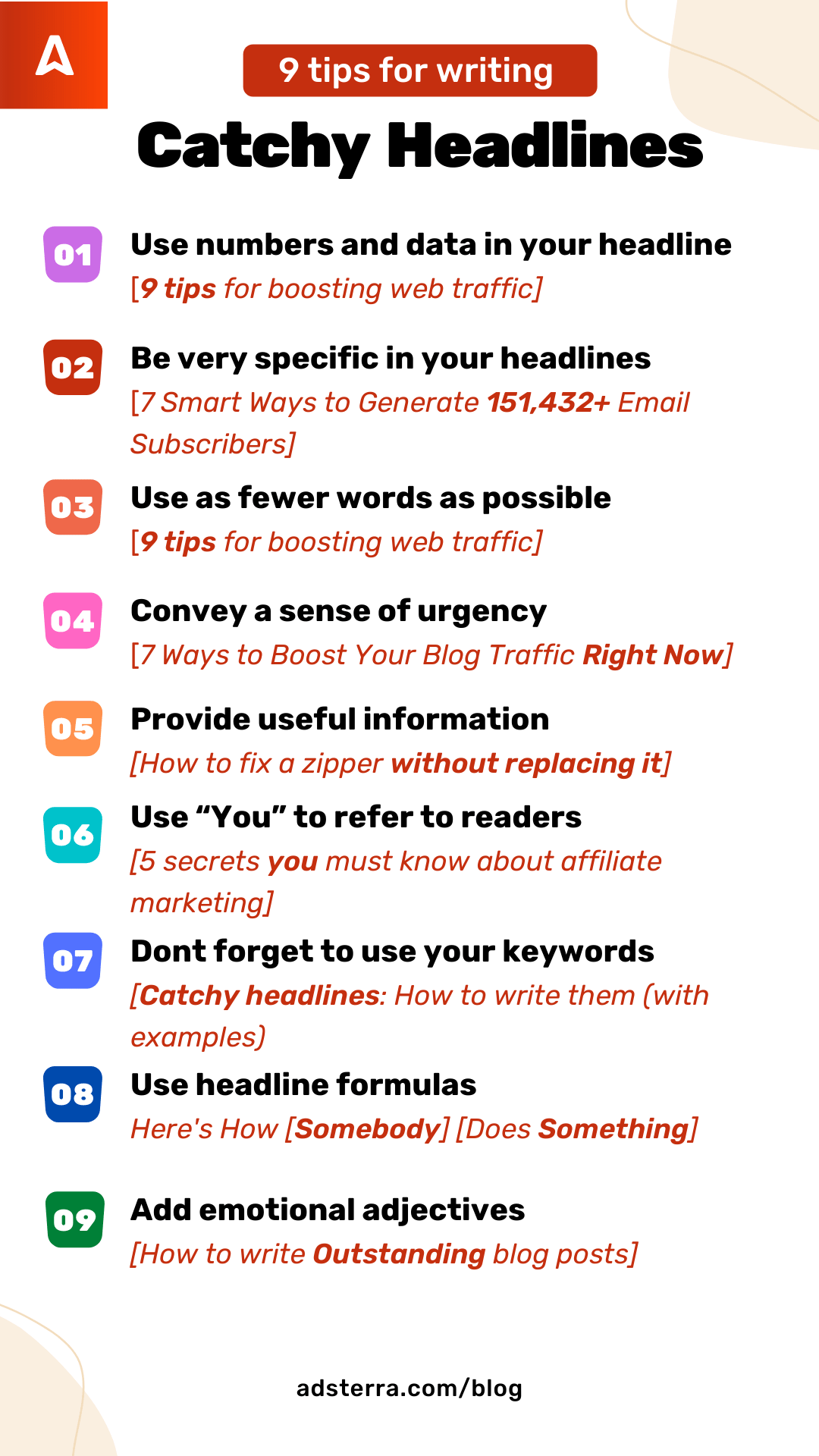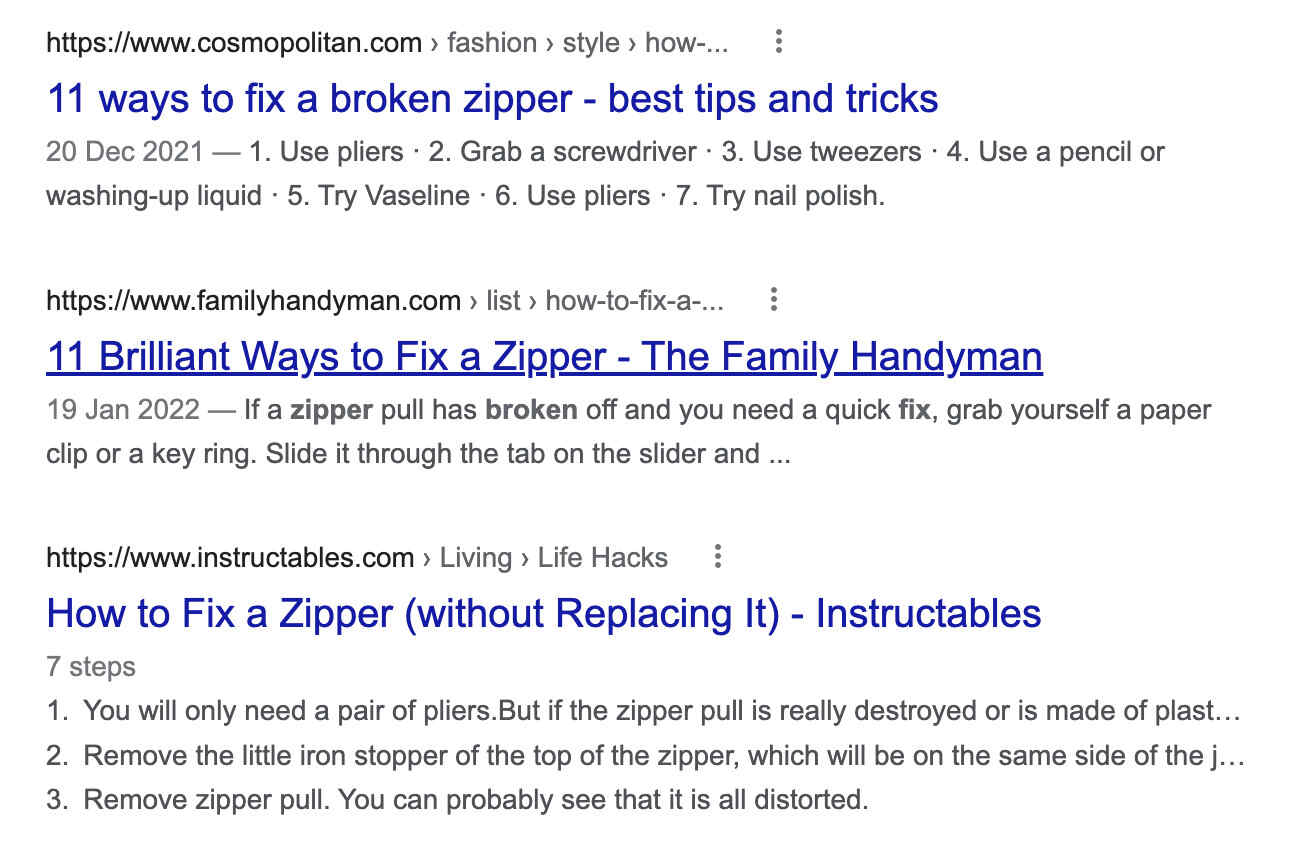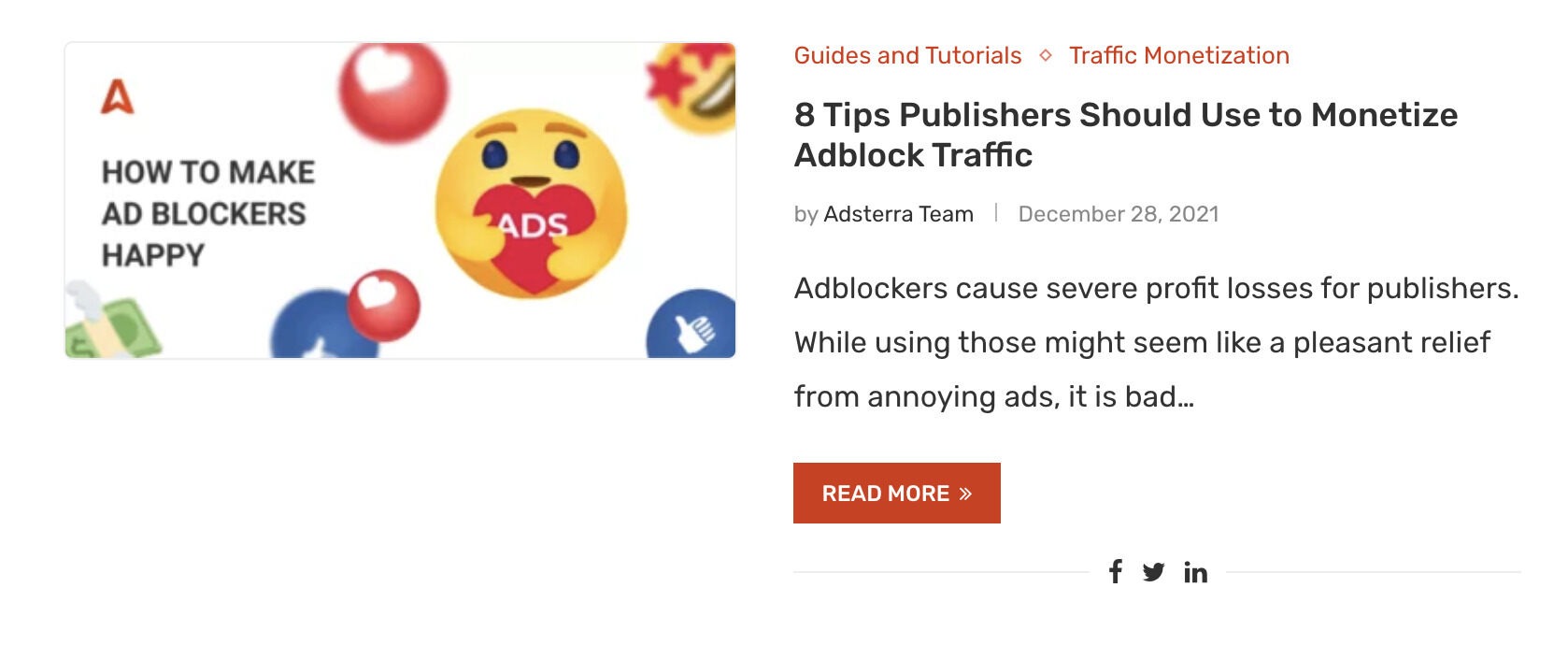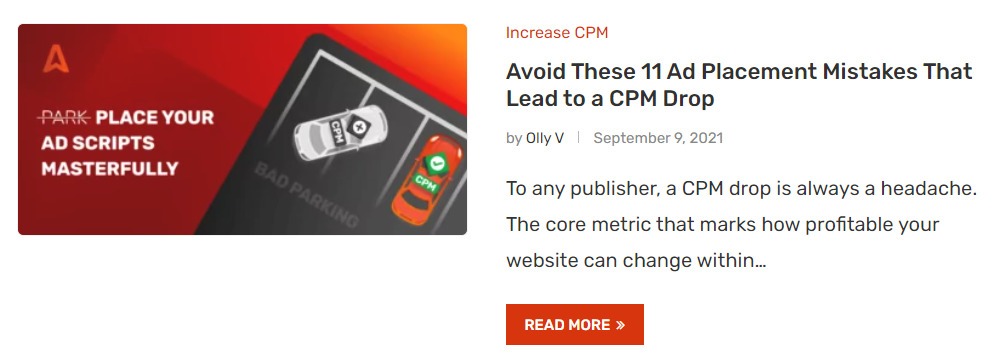Great headlines give you a competitive advantage by persuading your audience to read and reply to your powerful content. People will click on your content and share it with friends, family, and co-workers, even if they don’t read it to the end. And the more people you attract, the higher your chances of making more income from ads on your website or your landing pages with affiliate links. So in this post, we’ll share with you some tried-and-true tips and powerful headline formulas to help you attract, retain, and possibly convert your site visitors.

13 tips to writing catchy headlines for publishers and affiliates
The first impression you make on readers is through your headline. A catchy headline can help you get more clicks, while a boring one will drive traffic away. You’ll want to write good headlines that draw in readers, so here are 13 tips to write super fantastic headlines that WORK:
1. Use numbers and data in your headlines
An effective way of encouraging your readers to read your article is by using data and numbers in your headline. According to several studies, headlines with numbers are more likely to generate engagement and social shares. List posts are popular because they set expectations about content quantity, scannability, and variety. Additionally, numbers can represent data and statistics of research articles.
You should always use “7” in headlines instead of “seven.” If you’re writing a step-by-step guide, limit it to 9 steps. The human brain struggles to handle more than nine items consecutively. However, there is no limit to writing about tools or various methods of doing something.
If your article contains some vital points, adding a number in the headline can improve comprehension.
This headline is not catchy yet valuable. Remember that with Adsterra ads, you can increase your passive website earnings. Get income from ad views, clicks, and conversions
2. Be very specific in your headlines
Your content’s headline drives every piece you publish, regardless of format or platform. Your visitors have questions for which you need to provide answers. You can convert them into loyal readers and customers by creating ultra-specific headlines and solutions to their questions.
The more precise your headline is, the more authority you’ll have in your field, and the easier it’ll be to form strong bonds with readers.
A good example of this approach is Ryan Robinson’s blog headlines:
- 7 Smart Ways I’ve Generated 151,432+ Email Subscribers
- How to Create a Product Nobody Wants and Lose $6,537: The iStash Story

One of the keys to Ryan’s blogging success is his ability to be extremely specific.
3. Use as fewer words as possible
If you write a headline that isn’t easy to read or is too long, your readers will skip it right away. You only have a few seconds to catch your reader’s eye before they move on to the next page of their search results. Also, keep in mind that titles on Google have a 70-character limit. A 55-character headline proves to be universal and the most effective at generating click-through responses.
4. Convey a sense of urgency
A headline lacking urgency may cause readers to abandon your content or bookmark it and never return. Your goal should be to entice readers to click on your headline immediately. Headlines with a sense of urgency will always catch the reader’s attention because they make them anticipate what will happen next.
For example, ‘7 Ways to Increase Your Blog Traffic Right Now’ is more persuasive than ‘7 Ways to Increase Your Blog Traffic‘. Alternatively, you could emphasize the consequences of ignorance, such as ‘10 Mistakes You Don’t Want to Make While Running a Blog‘.
5. Provide useful info
Uniqueness, ultra-specificity, and urgency are all linked to usefulness. No matter the level of urgency you use, if the headline isn’t helpful, it will fail. You should give readers hope by showing them that their problem is still solvable.
Here’s an example:

6. Use simple and obvious words in your headline
Create headlines that are simple to understand. When a potential reader lands on your website, they should be able to figure out what you’re talking about immediately. The headline’s goal is to attract people to click so you can get a better ROI and not so the writer appears super intelligent. Replace complex words with their more common and simpler synonyms. Compare these headlines:
- How to Reach Your Target Audience with a Social Bar Ad Format
- How to Utilize the Social Bar Ad Format to Reach Your Target Audience
Both headlines have the same meaning, but the first one is far simpler and better for SEO.
7. Use emotional adjectives in your headlines
Adjectives play a vital role in both written and spoken English. They’re excellent for triggering emotion and keeping your audience engaged in a story. As a publisher, you can use adjectives to boost your headline and make it more appealing to your target audience.
You can also get ideas from a thesaurus, but ensure to use words the majority of visitors will understand. For example, everyone knows what “good” or “excellent” means, but “outstanding“ sounds more exciting.
8. Use “you” to refer to readers
This flagging technique is a great way to write headlines for both blog posts and landing page copy. One basic fundamental technique is referring to readers as “you.”
Headlines containing the word “you” generate a lot of engagement. Because it attracts your readers’ attention to the headline, it allows them to connect it to their personal experiences.
9. Use power words in your headlines
All words aren’t the same. Some words can inspire emotions, while others have no influence.
If you want your headline to sound promising about the content, it must create an emotional response from the audience. “Power words” refer to words that have a substantial emotional impact.
However, to avoid Google’s penalty for “keyword-bombing,” make sure they’re helpful to the user and read naturally. Your goal is to increase the conversion rate of your emails, blog posts, copy, and ads by using power words correctly.
10. Use headline formulas
Surprisingly, many of your shares come from people who have only read the catchy title. What makes a headline interesting and informative enough for people to click on and share it? Some formulas can be used over and over again. Here are nine formulas to help you write headlines that get people to read more, share, and pay attention.
- Surprise:
Surprise the reader by including something unusual in the headline. For example, “This Post Completely Sucks. Don’t Bother Reading” - Inquiries:
Ask a question with which the audience can identify. Make it unique. For instance, “Can You Write Adorable Headlines?” - Curiosity gap:
It’s all about boosting their interest by creating a massive “open loop” in which they want to involve themselves. For example: “11 Proven Headline Tips to Use in Your Next Blog Post. Number 9 Will Shock You.” - Drawbacks:
People seek pleasure and avoid pain. To some extent, pain is a stronger motivator than pleasure. As a result, headlines that address a problem and offer a solution can be effective. “Avoid These 4 Headline Mistakes“.
- Guidelines:
The traditional “how-to” article. Immediate value communication, as long as what you’re teaching them is something they want to do. For Instance: “How to Write Blog Headlines That Will Double Your Click-Through Rate“
- Referencing the audience:
Essentially, you’re identifying the headline with a specific target audience segment. An example is: “The Ultimate Guide To Writing Blog Headlines For Amateur Writers.”
- Who Else Wants [Something]?
A tried and tested headline format that offers social proof. By starting with “who else wants” you show that others have already done the impossible.
Who Else Wants to Earn $500 Daily by Hosting Ads? - Here’s How [Somebody] [Does Something]
It is simple, direct, and personal. Use this formula to make readers imagine themselves by replacing [somebody] with your target audience. Replace [something] with a benefit they want.
Here’s How You Can Triple Your Organic Traffic
- [X] Secret(s) of [something]
Another effective headline formula is to arouse interest. Who wouldn’t be interested in learning a safeguarded secret? Readers will believe that you have inside information, which makes the headline effective.
5 Secrets to Profitable Traffic Buying for Affiliates
11. Stand out from the crowd
Writing competitively similar articles forces everyone to follow a set of rules. Like any other form of marketing, creative marketing loses effectiveness when everyone else does it the same way.
Therefore, it’s important to be unique.
12. Don’t forget to use your SEO keywords
By starting the title tag <title> and header <h1> with the target key, you give it “keyphrase prominence,” which helps search engines determine its relevance.
Catchy Headlines: How to Write Them (Tips and Examples)
A compelling headline is beneficial to both search engines and readers. You can use a colon in your headlines to help them rank and grab attention. Colons help you differentiate between search-friendly keywords and social-friendly triggers.
Despite the growing importance of social sharing, Google remains the primary traffic source for websites. After completing the preceding steps, think about the keywords you’re using in your headlines.
13. A/B test your headlines
Split testing headlines is the most effective way to discover what makes a good headline. Rather than selecting the most appealing headline, you should choose two and compare them. You can A/B test your headlines by sending two different headlines via email and see which one performs better.
Conclusion
Take extra time to consider which headline will capture the most attention, and ensure that it accurately describes your content while remaining attractive. Then you will get a powerful combo then: a headline that catches attention and content that makes users read till the end. This improves a vital website metric: the Average time on page. The more time users spend reading, the higher your ranking are and the more ads they can watch. If you ever thought of driving a profit from your website or blog (and you should have to), give Adsterra a try. We have lots of modern ad formats that fit any website layout: Native Banners, In-Page Push, Popunders, and many more.




